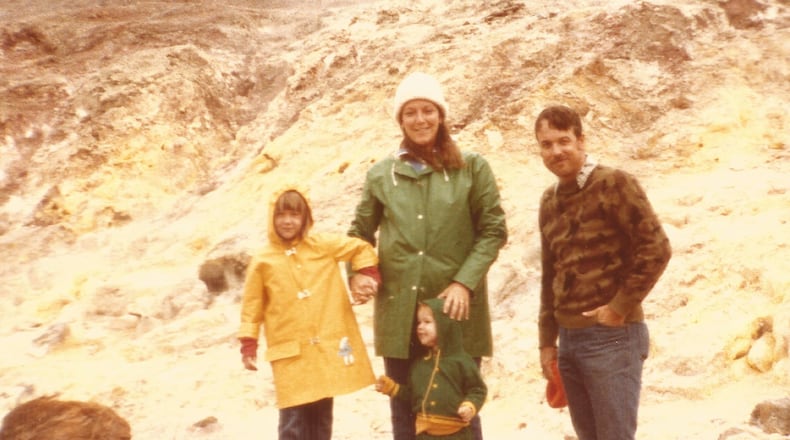RELATED: Memories of living in Hawaii rush back as volcano erupts
Years ago after my flight over the lava fountains of Mauna Loa and Kilauea, we returned many times to see the volcano up close.
Although Mauna Loa fell back to sleep, Kilauea’s eruption continued in a slow and steady manner for decades.
On our first visit back we drove to Kalapana to see the black sand beaches created by the erosion of old lava. We visited the historic Queen’s Bath, where Hawaii royalty had enjoyed a fresh water swimming pond surrounded by palms and flowers, and the beautiful Star of the Sea Painted Church on the shore line.
On another visit I ran a 10 mile race around the edge of Kilauea’s huge summit crater, and its inner crater Halemaumau. That is right, that summit crater had a circumference of nearly 10 miles. My husband ran a marathon around the crater and adjacent lava flows. The volcano at that level was only steaming. The lava was flowing from a vent half way down the slope. The rock formed from the hardened lava was sharp and could ruin a pair of shoes in one run or a knee in one fall.
We were fascinated by all the forms that lava can take. A’a lava is rough, with sharp edges and resembles furnace clinkers. Two-story high walls of a’a (pronounced Ah-Ah) can bulldoze a town. Once it has cooled it is very difficult to walk on.
A smooth, viscous flow of lava is pahoehoe (pronounced Pah-Hoy-Hoy). It is thick and smooth like fudge or hardened tar.
When lava is fountaining with great pressure and the wind is blowing the lava can harden into long strands of glass that resembles hair, blond hair, scattered on the ground like on the floor of a beauty shop. This is called Pele’s hair.
Foamy lava that is ejected under pressure has many air pockets in the rock. It is called pumice and can float.
Lava bombs are spatters of red hot liquid lava that cools and solidifies as it is ejected and flies through the air. These can be small or large as a boulder. (One Hawaiian man who got too close had his leg broken by a lava bomb recently.) A year after the races we returned to the island to find the black sand beach at Kalapana, the Queen’s Bath and the fishing village under a thick layer of a’a lava. Only the old wooden church remained because it had been loaded on a semi truck trailer and relocated at the last minute. The coast line was nearly half a mile farther out into the ocean. The island had grown.
MORE BY PAM COTTREL
Farm Day brings high school, elementary students together
Clark County has front row seat to aviation wonders
Near Royal Gardens subdivision we walked on the rusted roofs of cars and houses that had been overrun by the lava flows months before. It was strange to see a stop sign sticking out of rock.
On our last trip to the volcano the races had been cancelled because of the eruption disturbed the route.
On our explorations we finally came face to face with an active lava flow. The air smelled of sulfur and burned wood as we walked to a narrow lava flow creeping toward the sea. At night it would have glowed orange but in the daylight it was dark red with a thin silvery shell-like layer coating its surface. When that silvery shell cracked, more red lava would ooze out like red icing and continue forward towards the sea.
As it flowed, the lava spoke in a metallic cracking voice.
No wonder the ancients felt it was alive.
The lava had a dangerous pull on us. I was particularly under its spell. I wanted to get closer, but we had to be cautious. Getting too close to the nearly 2000 degree lava flow could have singed our eyebrows or worse. It was more intensely hot than any bonfire.
We had walked across new, but cooled lava to get to the active flow, but on the way back to the car we realized that it wasn’t as cool as we had thought. The soles of our running shoes had begun to melt.
That was when my husband told me it was time to move back to the Mainland to get me away from the mesmerizing and dangerous lava. He was right.
To this day when I see fountaining lava like at Puna I feel the urge to rush to the airport.
I feel sad for those who have lost their homes. It is hard to imagine that 100 homes where overrun in one night last week. Such a swift lava flow is scary and I hope people continue to stay out of its way.
It has been almost 30 years since Kalapana was overrun by the lava flows. I saw photos recently of a new black sand beach that is forming as the new coastline begins to erode. Ferns and palm trees are already taking root and reclaiming the land. The process of converting the lava to soil has begun and the island continues to evolve.
Some day coconut trees will grow again in today’s disaster area, but not soon.
About the Author
